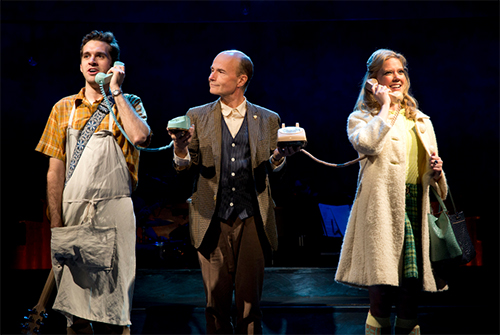Translate Page

How the Fly By Night team created their unusual new musical
----
Most musicals have multiple authors, and the division of labor is typically pretty clear. While everyone might contribute ideas, it's Stephen Sondheim, say, who's ultimately responsible for the music and lyrics, while James Lapine tackles the book.
But Fly By Night, now at Playwrights Horizons, is a different animal. The show's three writers---Kim Rosenstock, Michael Mitnick, and Will Connolly---created everything together, sharing credit across the board.
So how does that work? It's hard enough for one person to write a show, so how do three artists, each with their own sensibility, create something unified?
It helps that all three collaborators were classmates at Yale School of Drama (Rosenstock and Mitnick were in the playwriting program, and Connolly was an actor.) Living in the intense YSD environment, where a small group of students is together every waking minute in a roughly six block radius, provides incredible insight on another person's talent and temperament. If you're going to click with someone (or not), there's no better way to find out.
Mitnick, Rosenstock, and Connolly clicked. In fact, Fly By Night, a romantic fable set during the 1965 New York City blackout, began in 2009 as a project at Yale Cabaret, a theatre run by Drama School students. That's where the trio learned how to work together.
"We just sat in the attic of the Yale Cabaret for months, and it was like a lab with mad scientists," Rosenstock recalls. "Every day, you'd come in and somebody would be at the piano, somebody would be with a guitar, somebody would be writing something on a white board. There were always these little presentations. 'Here's this thing that I just did. What do you think?' And then the other two would say, 'Okay, here's what I think of it. Can I take it and do this to it?' Everything always cycled back through each of us."
They refined their process as the show moved on. The Cabaret staging was followed by intense workshops and two more full productions, one at TheatreWorks in Palo Alto, California and one at the Dallas Theater Center.
By now, the writers have mastered their shared language. Sitting together in a conference room at Playwrights Horizons, they easily finish each other's sentences or speak in a shorthand of references and quirky phrases. Naturally, that symbiosis informs their musical as well. As Mitnick says, "Our friends will come to us and say, 'Michael, you wrote that tune, right?' And actually, it'll be one that Kim wrote. Or they'll say, 'It sounds like Kim wrote those lyrics,' and it'll be lyrics that Will wrote."
But that doesn't mean <em>Fly By Night</em> came to New York as a finished project of the hive mind. The team has made significant changes for the Off Broadway production, and they've discovered new things about the material.
For instance, they've got a fresh take on the magical-realist structure, which rarely tells a story in a straight line. As Harold, a struggling singer-songwriter, navigates his love for an actress named Daphne and a diner waitress named Miriam, key moments get replayed multiple times. Meanwhile, we'll occasionally see the end of a scene before the beginning, or a narrator might pop in to comment on why a certain line is so important. This fractured storytelling creates a lively energy, and it toys with the idea of what's inevitable in our relationships.
And now, thanks to a recent rewrite, that spirit is reflected even more fully by the score. Every character has a distinct musical theme, and during a pivotal confrontation, Miriam and Henry now swap themes, letting the music itself suggest how they're connected. "Will came up with this idea that he will sing her music and she will sing his music," Rosenstock says. "Even though she's saying, 'We shouldn't be together,' it's undercut by the fact that she's singing his music. To be able to do that musically, as well as with words, was so exciting."
Mitnick adds, "On a nerd level, it's fun to write a show where you can take a song and shatter it and combine it with another song, but then you realize, 'Oh, these were actually engineered to go together.' It's very satisfying for an audience, I think, to feel that payoff.'"
But for all this clever tinkering, the trio has also been simplifying things. "There's a tension because we're writing a show that's structured like a fable, but we don't want there to be a clear moral," Rosenstock explains. As a result, "summary moments" have been stripped away.
That's why New York audiences don't hear a song immediately after a tragic event in the second act. Or rather, they hear music without lyrics. Explaining the change, Connolly says, "The idea of people singing in that moment might be structurally acceptable, but it somehow just didn't feel right. Personally, I don't think I have the words to describe what it's like to go through that kind of loss. I'd say the melodies speak for themselves, and I'm glad we're letting them do that now."
---
Mark Blankenship is TDF's online content editor
Photo by Joan Marcus